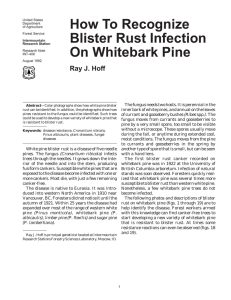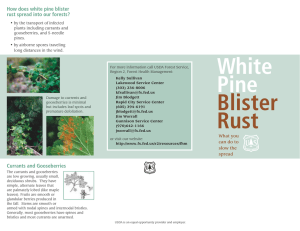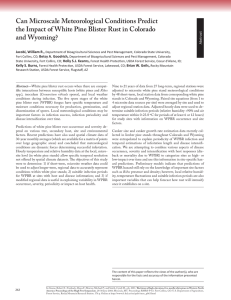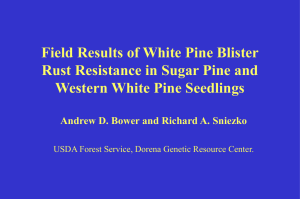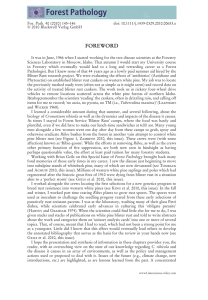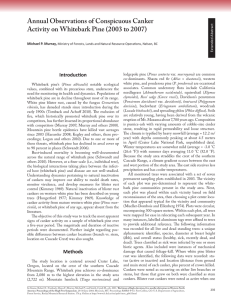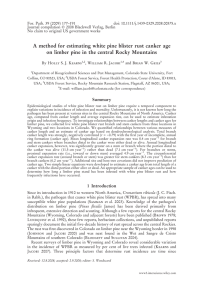How To Recognize Blister Rust Infection On Whitebark Pine Ray J. Hoff
advertisement
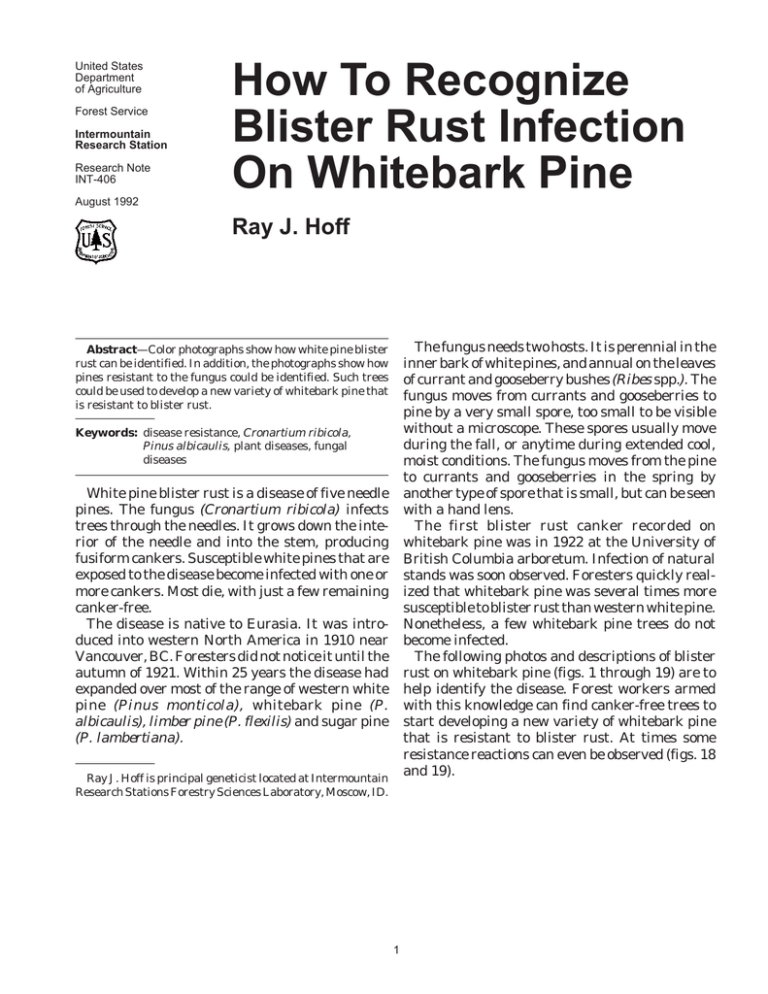
United States Department of Agriculture Forest Service Intermountain Research Station Research Note INT-406 How To Recognize Blister Rust Infection On Whitebark Pine August 1992 Ray J. Hoff The fungus needs two hosts. It is perennial in the inner bark of white pines, and annual on the leaves of currant and gooseberry bushes (Ribes spp.). The fungus moves from currants and gooseberries to pine by a very small spore, too small to be visible without a microscope. These spores usually move during the fall, or anytime during extended cool, moist conditions. The fungus moves from the pine to currants and gooseberries in the spring by another type of spore that is small, but can be seen with a hand lens. The first blister rust canker recorded on whitebark pine was in 1922 at the University of British Columbia arboretum. Infection of natural stands was soon observed. Foresters quickly realized that whitebark pine was several times more susceptible to blister rust than western white pine. Nonetheless, a few whitebark pine trees do not become infected. The following photos and descriptions of blister rust on whitebark pine (figs. 1 through 19) are to help identify the disease. Forest workers armed with this knowledge can find canker-free trees to start developing a new variety of whitebark pine that is resistant to blister rust. At times some resistance reactions can even be observed (figs. 18 and 19). Abstract—Color photographs show how white pine blister rust can be identified. In addition, the photographs show how pines resistant to the fungus could be identified. Such trees could be used to develop a new variety of whitebark pine that is resistant to blister rust. Keywords: disease resistance, Cronartium ribicola, Pinus albicaulis, plant diseases, fungal diseases White pine blister rust is a disease of five needle pines. The fungus (Cronartium ribicola) infects trees through the needles. It grows down the interior of the needle and into the stem, producing fusiform cankers. Susceptible white pines that are exposed to the disease become infected with one or more cankers. Most die, with just a few remaining canker-free. The disease is native to Eurasia. It was introduced into western North America in 1910 near Vancouver, BC. Foresters did not notice it until the autumn of 1921. Within 25 years the disease had expanded over most of the range of western white pine (Pinus monticola), whitebark pine (P. albicaulis), limber pine (P. flexilis) and sugar pine (P. lambertiana). Ray J. Hoff is principal geneticist located at Intermountain Research Stations Forestry Sciences Laboratory, Moscow, ID. 1 2 1 Figures 1 and 2—These red-brown branches (flags) are evidence that blister rust is present. 3 4 Figures 3 and 4—The first signs of a stem infection are these yellow-orange patches on the stem. These infections are about 1 year old. 2 5 6 Figure 5—(Above left) This canker is 4 to 5 years old. A yellow-orange margin is visible at the base. The center is rough and broken due to fruiting of the fungus in previous years. The white areas in the lower right side are remnants of fruiting in the current year. Figure 6—(Above) The fungus within this canker has not fruited, so the bark is still smooth. However, there is a hint of yellow-orange color, especially in the upper one-half of the canker. If this portion were rubbed with a little water, the color would become visible. Figure 7—(Left) High amounts of sugars are associated with blister rust cankers. Ants, grasshoppers, mice, and other rodents feed on these sweet cankers. 7 3 9 8 Figure 8—The white material on this canker is the remnant of fruiting during the current year. The fruiting structures originate within the stem. As they grow, the bark ruptures. Figure 9—This is the lower part of the canker in figure 8. The area has been rubbed with a little water to reveal the yellow-orange margin—a sure sign of a blister rust infection. 10 11 Figure 10—Two cankers are visible here. The upper one is still living. The lower one has caused the branch to die. As the fruiting structures of the fungus grow, living cells within the stem are broken, crushed, or dried. Figure 11—This canker has killed the branch, which has become a “flag”. A rodent appears to have made a meal of the sweet, succulent tissue. 4 12 13 Figure 12—(Above left) Fruiting lags a year or two behind the growing margin of the canker. The stem, or top of a tree, does not die until the fungus has grown and fruited completely around it. Figure 13—(Above) This photo shows the canker that killed the top of the tree in figure 12. Typically, the dead bark is still present and a lot of pitch is associated with the dead portion of the canker. Pitch usually drips and runs down the stem. Figure 14—(Left) The top of this young tree has been killed by blister rust. A large stem canker is still visible. Several flagged branches and a couple of branch cankers are visible on the middle-right side of the tree. 14 5 15 16 Figure 15—A fairly old canker. This canker has fruited. However, it doesn't seem to be very active. No yellow-orange margin is visible. Figure 16—An old, dead canker. Figure 17—Four dead cankers are visible. Can you find them? 17 6 18 19 Figures 18 and 19—Cankers appear to have been suppressed by a defense reaction in the tree. These two trees are resistant to blister rust. Living stem tissue in the area shown is dead. This reaction is similar to that observed in western white pine. The death of host cells may be related to the amount of fungus mycelium present, or to the physical environment. The tree builds a wound periderm around the infection. The death of the pine cells and development of the periderm starve the fungus. Intermountain Research Station 324 25th Street Ogden, UT 84401 Printed on recycled paper 7 INTERMOUNTAIN RESEARCH STATION The Intermountain Research Station provides scientific knowledge and technology to improve management, protection, and use of the forests and rangelands of the Intermountain West. Research is designed to meet the needs of National Forest managers, Federal and State agencies, industry, academic institutions, public and private organizations, and individuals. Results of research are made available through publications, symposia, workshops, training sessions, and personal contacts. The Intermountain Research Station territory includes Montana, Idaho, Utah, Nevada, and western Wyoming. Eighty-five percent of the lands in the Station area, about 231 million acres, are classified as forest or rangeland. They include grasslands, deserts, shrublands, alpine areas, and forests. They provide fiber for forest industries, minerals and fossil fuels for energy and industrial development, water for domestic and industrial consumption, forage for livestock and wildlife, and recreation opportunities for millions of visitors. Several Station units conduct research in additional western States, or have missions that are national or international in scope. Station laboratories are located in: Boise, Idaho Bozeman, Montana (in cooperation with Montana State University) Logan, Utah (in cooperation with Utah State University) Missoula, Montana (in cooperation with the University of Montana) Moscow, Idaho (in cooperation with the University of Idaho) Ogden, Utah Provo, Utah (in cooperation with Brigham Young University) Reno, Nevada (in cooperation with the University of Nevada) USDA policy prohibits discrimination because of race, color, national origin, sex, age, religion, or handicapping condition. Any person who believes he or she has been discriminated against in any USDA-related activity should immediately contact the Secretary of Agriculture, Washington, DC 20250 8
